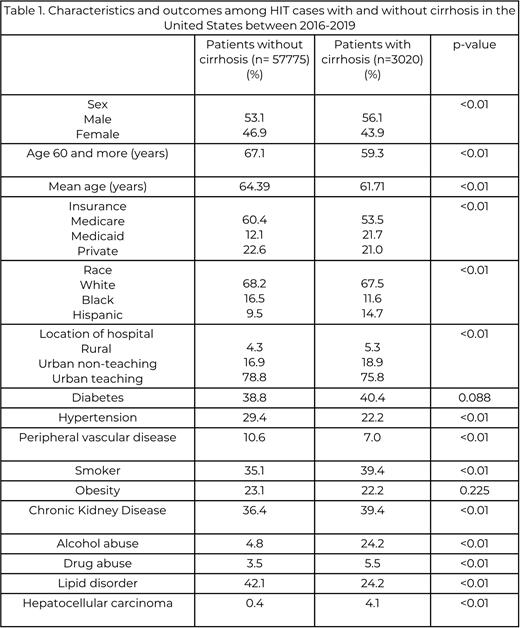Introduction: Heparin-induced thrombocytopenia (HIT) is characterized by thrombocytopenia and a prothrombotic state. It can occur following the use of heparin products of any form or dosage. Various factors predispose cirrhosis patients to thrombocytopenia, such as splenic platelet sequestration, lower levels and activity of thrombopoietin (TPO), bone marrow suppression secondary to chronic viral infections(e.g., Hepatitis C), and use of antiviral therapies such as interferons. As there is a paucity of data on the impact that cirrhosis confers on the outcomes following HIT, we conducted a retrospective nationwide analysis.
Methods: A retrospective study of adult patients with HIT was performed using the2016-2019 National Inpatient Sample(NIS), a set of annual hospitalization databases produced by HCUP, AHRQ, and multiple partners. Patients with HIT were identified via the ICD-10 code “D7582”. We studied the differences in patient characteristics and multiple comorbidities among patients with and without cirrhosis, along with the impact on outcomes.
Results: Our study included a total of 60800 cases of HIT, which included 3020(5.0%) cases with a diagnosis of cirrhosis (Table 1). The majority of cases involved patients classified as White, were Medicare-insured and underwent treatment in Urban-teaching centers.
While patients with cirrhosis were younger (mean age 61.71 years vs. 64.39 years, p<0.01), they also reported disparities in patient characteristics and comorbidities. Cirrhosis cohort had fewer females (43.9% vs. 46.9%, p<0.01), lower prevalence of hypertension (22.2% vs. 29.4%, p<0.01), peripheral vascular disease (7.0% vs. 10.6%, p<0.01), lipid disorders (24.2% vs. 42.1%, p<0.01), and were overall younger (mean age 61.71 vs. 64.39 years, p<0.01). However, cirrhosis patients showed a higher prevalence of smoking (39.4% vs. 35.1%, p<0.01), chronic kidney disease (39.4% vs. 36.4%, p<0.01), and alcohol abuse ( 24.2% vs. 4.8%, p<0.01).
Moreover, 4.1% of cirrhosis patients had a diagnosis of hepatocellular carcinoma (vs. 0.4% of non-cirrhosis patients, p<0.01). No differences in the two groups were observed for diabetes and obesity. Overall, cirrhosis patients reported a higher mean Charlson Comorbidity Index (CCI) score (6.21 vs. 4.58, p<0.01) but had a shorter stay (13.84 days vs. 14.64 days, p<0.01), with a lower mean hospital charge ($167196 vs. $225959, p<0.01).
After careful adjustment of confounders, lower odds of Major adverse cardiovascular events (MACEs) were seen among cirrhosis patients (14.2% vs. 19.3%,aOR 0.531, 95% CI 0.474-0.595, p<0.01). Moreover, cirrhosis patients also had lower odds of in-hospital death following events of HIT (11.4% vs. 10.9%, aOR 0.875, 95% CI 0.770-0.994, p=0.040).
Conclusion: Our study found lower odds of MACEs and mortality among cirrhosis patients in cases of HIT. However, as the NIS has multiple limitations, such as the unavailability of medication codes and the inability to evaluate post-discharge outcomes, we highly encourage more in-depth studies to improve our understanding of the impact of cirrhosis in patients with HIT.
Disclosures
No relevant conflicts of interest to declare.


This feature is available to Subscribers Only
Sign In or Create an Account Close Modal